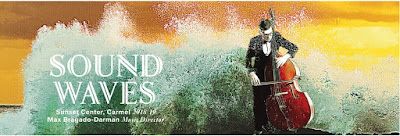A spectacular lineup of guest performers are poised to make the 73rd season of the Monterey Symphony a special one for local music aficionados who, from October to May, will be treated to a series of six concerts, featuring some of the most-iconic compositions of all time.
Salinas, CA, April 07, 2018 – A spectacular lineup of guest performers are poised to make the 73rd season of the Monterey Symphony a special one for local music aficionados who, from October to May, will be treated to a series of six concerts, featuring some of the most-iconic compositions of all time.
Tickets (priced from $10-$84, with student and military discounts available) and additional information can be obtained online by visiting the website at www.montereysymphony.org, or by calling 831-646-8511. Tickets also will be sold at the box office on performance days.

Here’s a preview of a season entitled Sound Waves, which promises to be a memorable series of shows, which will include Saturday-evening performances at 8 p.m., and Sunday matinees at 3 p.m., at the fabulous Sunset Center (Ninth Avenue and San Carlos Street, Carmel).
Program 1 — Oct. 20-21
The 2018-19 season debuts with a program showcasing conductor Max Bragado-Darman and the Monterey Symphony performing a new work from compose Alex Berko commissioned with the Big Sur Land Trust, plus Franz Shubert’s Symphony No. 9, “The Great.”
Berko, an exceptional student at the Jacobs School of Music at Indiana University, drew his inspiration for his new orchestral work, Among Waves, from the deep beauty of the landscape during a week in residence at Glen Deven Ranch in Big Sur.
Glen Deven Ranch also played a role in the first commission with the Big Sur Land Trust, resulting in Big Sur, the Night Sun, by esteemed composer John Wineglass, performed by the Monterey Symphony on the opening weekend of last year’s concert series.
Program 2 — Nov. 17-18
Tchaikovsky’s Symphony No. 4, Op. 36 (often referred to as the “Fate” symphony because of its dark undertones) headlines the second concert of the series.
Written in the shadow of Beethoven’s masterful Symphony No. 5, Tchaikovsky echoes the great master’s melancholy in this hallmark orchestral work.
Celebrated American flautist Carol Wincenc, a professor at The Julliard School, will be spotlighted during this same program, joining the orchestra for Carl Nielsen’s Flute Concerto, composed in 1926 for legendary flautist M. Holger-Gilbert Jespersen. This concert also will feature members of the Youth Music Monterey County Honors Orchestra, playing side-by-side on Hector Berlioz’s Overture, Le corsair, Op. 21, which, like the Tchaikovsky symphony, was also composed during a period of great despair.
Program 3 — Feb. 16-17
The third weekend of the “Sound Waves” season comes alive with four works, each of which is dedicated to the sea.
Claude Debussy, the father of Impressionism in music, composed La Mer in the mold of a symphony, but eschewed the traditional title for one more authentic to the sound of the music.
French composer Jacques Ibert, director of French opera in Rome, wrote Escales — a suite for orchestra that perfectly resembles postcards from three Mediterranean ports — after finding his obsession with the sea.
This concert also features “Four Sea Interludes” from Peter Grimes, Op. 33a, by Benjamin Britten, England’s finest modern opera composer. Composed in 1945, the piece launched the career of Grimes in the new postwar era. The gorgeous tone-poem Oceanides, Op. 73, by Jean Sibelius, was inspired by the haunting and tempting sea nymphs referenced in Greek mythology.
Program 4 — March 16-17
Jung-Ho Pak will be guest conductor for the fourth concert of the season, featuring the works of Tan Dun, Shostakovich, and Alan Hovhaness.
The revolutionary experimental composer Tan Dun transposes the sounds of water — at play and at work — into the textures of his music, most literally in Water Concerto for water percussion and orchestra.
Hovhaness’ symphonic poem, And God Created Great Whales (commissioned in 1976 by the New York Philharmonic), featuring prerecorded humpback whale vocalizations, was credited with early efforts to save whales from extinction.
And Dmitri Shostakovich was commissioned to write Symphony No. 9 — described by Leonard Bernstein as a series of musical jokes (including purposeful mistakes) — to celebrate the Soviet victory over Germany.
Program 5 — April 13-14
Three Romantic German composers are featured in the fifth concert of the season, a program that opens with Mendelssohn’s concert overture, Calm Sea, and Prosperous Voyage, Op. 27, inspired by Beethoven’s work of the same name.
Solo artist Elmar Oliveira returns with the Monterey Symphony to perform Violin Concerto No. 1, Op. 26, by Jewish composer Max Bruch.
And Robert Schumann’s Symphony No. 4, Op. 120, originally from his unpublished second symphony, underwent massive revisions in 1851 (five years before his death), proving his mastery over orchestration and increased expression in the final edition of this emotional Romantic symphony.
Program 6 — May 18-19
The sixth and final concert of the season will conclude in grand fashion with music by Wagner, Chopin, and Beethoven.
Richard Wagner composed brilliant overtures throughout his many German operas, including the overture from The Flying Dutchman, which will be showcased as the opening work in the season finale.
Chopin’s stunning Piano Concerto No. 2, Op. 21 — composed before he completed his formal education at age 20 — follows, will be performed by magnificent Cuban pianist Marcos Madrigal.
And the season ends with one of the all-time greatest compositions for the concert hall, Beethoven’s Symphony No. 5, Op. 67. A favorite among experienced and new audiences, musicians, and conductors, the fifth endeavor in the symphony genre struck a chord for Beethoven as he discovered his true forte. It is the “Stairway to Heaven” of classical music!
Contact:
Marci Bracco Cain
Chatterbox PR
Salinas, CA 93901
(831) 747-7455
http://www.montereysymphony.org

